Software Solutions You Need to Scale Small Businesses [A Guide]

Table of contents
Starting and scaling a digital business, whether you’re operating in B2B or e-commerce, is a lot simpler today than it was a few years ago. There’s a bunch of well-designed, business software built to help you run businesses effectively. Add to that the recent developments in AI capabilities, and you can get a lot done with very lean teams.
In fact, one thing I’ve noticed of late is one-person businesses (solopreneurs) building profitable businesses at remarkable scale. If you’re active on the interwebs, you’ve likely heard of Pieter Levels aka levelsio. He’s built several businesses online all by himself. For context, here’s his bio on X.

Even among my peer group I’m seeing a greater desire to start and run businesses because of the lower barriers to entry.
The point I’m trying to make here is, running and scaling small businesses has literally never been easier, you just need to invest in the right set of software solutions. In this article, I’ll take you through the essential software you need to grow small businesses.
Let’s jump right in.
Table of Contents
- A rundown of the 5 types of software your small business needs along with examples
- Kicking off your growth story as a small business
A rundown of the 5 types of software your small business needs along with examples
Here are the 5 types of software solutions you should consider as a small business if you want to streamline your processes and take it to the next level.
1. Accounting and bookkeeping software
This is true at any scale – the way you manage your finances can make or break your business. But even more so as a small business, you want to make sure you know where your money is going and how it’s being used. Every dollar counts. Whether or not you have an accountant as a full-time employee on your team, I believe you should look into accounting and bookkeeping softwares.
These tools can save you from a lot of headaches down the road. They give you a real-time view of your cash flow, help you stay on top of bills, and even handle things like payroll and taxes with minimal effort on your part. So even if you don’t have a finance expert on your team, they’re intuitive enough for you to use.
Let’s look at a couple of examples of accounting and bookkeeping software for smaller businesses.
Wave Accounting: Wave Accounting is a great choice for startups and small businesses. It has a free model that lets you get all the basic functionalities like accounting, invoicing, and receipt scanning. That makes it ideal for teams that are operating on a tight budget. Later as you grow, you can add on optional services like payroll or payment processing for a fee.
Wave is also specifically designed keeping small businesses in mind. The whole point is to take as much of the leg work out of accounting as possible.
It allows you to manage your cash flow, track expenses, and create professional invoices all in one place. It’s extremely user-friendly and offers features like bank account integration for automatic transaction importing, which cuts down manual data entry. It also provides detailed financial reports, so you can easily see where your money is going.

Intuit Quickbooks: If you’re looking for a comprehensive accounting solution that scales with your small business, I believe QuickBooks is one of the best options out there. It’s designed to handle everything from basic bookkeeping to more advanced accounting needs as your business grows. It’s key features include:
- Invoicing – You can create professional, customizable invoices and even automate reminders for unpaid ones. This is super handy if you want to keep cash flow steady and ensure payments aren’t missed.
- Expense Tracking: Automatically categorize expenses by linking your bank accounts and credit cards to QuickBooks. This cuts down on manual entry and helps you get a clear picture of your cash flow at any time.
- Payroll Management: QuickBooks allows you to manage the complete payroll process, which is perfect for growing businesses. You can do tax calculations, make payments, and even process direct deposits for employees.
Quickbooks starts at $17.50 per month for US-based users. It also comes with a 30 day free trial.
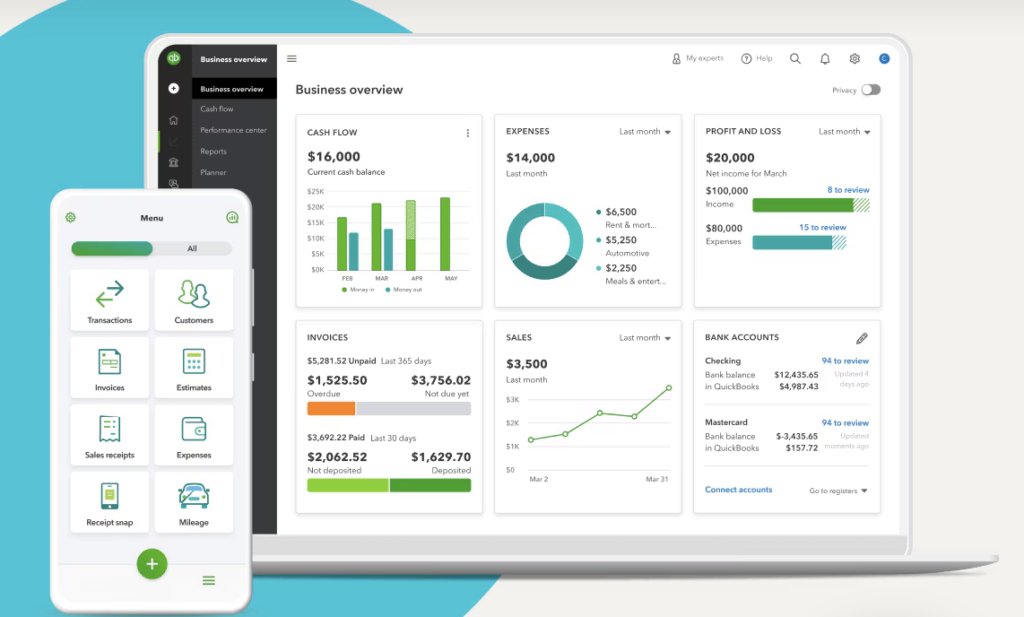
Both Wave Accounting and QuickBooks are excellent choices for small businesses, but they cater to slightly different needs.
Here’s a useful Reddit thread discussing the pros and cons of each tool that you can refer to: Wave vs Quickbooks.
2. Customer support software
Investing in a good customer service software will give you exponential returns. When you build a reputation as a business that listens to its customers and takes care of them, you’ll have customers who trust you and come back to you repeatedly. These customers will also talk about you to their friends and family. Word-of-mouth marketing from satisfied customers is incredibly powerful and far more effective than any paid advertising.
Customer support tools allow you to manage all customer inquiries in one place, track previous interactions, and even automate routine tasks like follow-ups and updates. This means that even without a large support team, you can provide quick, efficient responses that make customers feel valued and heard.
Hiver:Hiver is a powerful customer service software that essentially brings all your customer support channels like email, live chat, WhatsApp, and phone into one unified platform i.e. your inbox. You can do everything from responding to customers, managing SLAs, maintaining a knowledge base, and reporting and analytics from the comfort of your inbox (Outlook or Gmail).
Since the tool turns your email inbox into a customer support tool as opposed to moving you to a new platform, it’s very intuitive and easy to use. Hiver requires very little training or set-up and you can hit the ground running from day 1. This is very important for small businesses because there’s no additional training costs and you’re not wasting any time on onboarding and training.
Hiver offers all the necessary features you could want in a customer service tool such as:
- Assignment and tracking queries – Hiver converts all incoming queries into tasks irrespective of which channel they’re coming from. You can easily assign these tasks to team members (manually or automatically),track their status, and ensure that no inquiry falls through the cracks.
- Automation and workflow management: Hiver helps streamline your support process with automation. You can automatically assign tasks, set rules to categorize queries, and use templates for answering commonly asked questions. This saves a lot of time and can be really useful for smaller teams.
- Analytics and reporting: Hiver offers detailed reporting features that track metrics such as first response time, average resolution time, and customer satisfaction scores (CSAT). These insights help you evaluate and improve support performance over time.
- Knowledge base: Hiver also lets you create and manage a knowledge base for internal or external use. Offer your customers a self-service option that they can use for common queries they might have. This also reduces the volume of queries your agents have to field.
Hiver has a 7-day free trial. After that, you can either opt for Hiver’s forever free plan or one of Hiver’s paid plans depending on your specific use case. Hiver’s paid plans start from $19 per user per month.
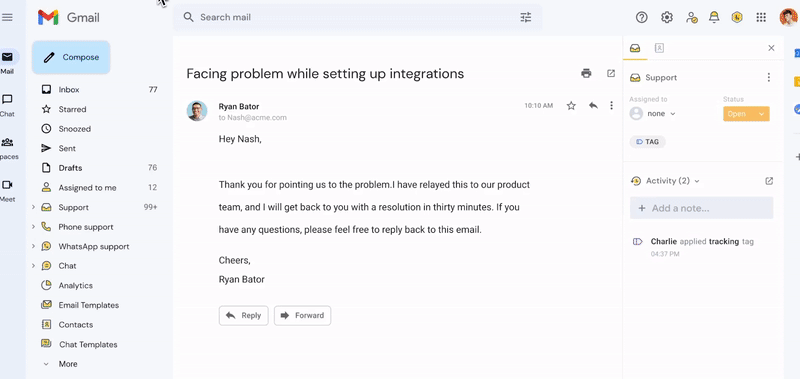
Help Scout: Help Scout is another great choice for growing customer support teams looking to offer email and chat support.
It comes with a rich feature set, including capabilities like ticket routing and prioritization, task automation, agent performance reports, collision detection, and response templates, amongst many others.
Help Scout’s pricing starts at $22 per user per month. There’s a 15-day trial in case you want to try it out with no strings attached.
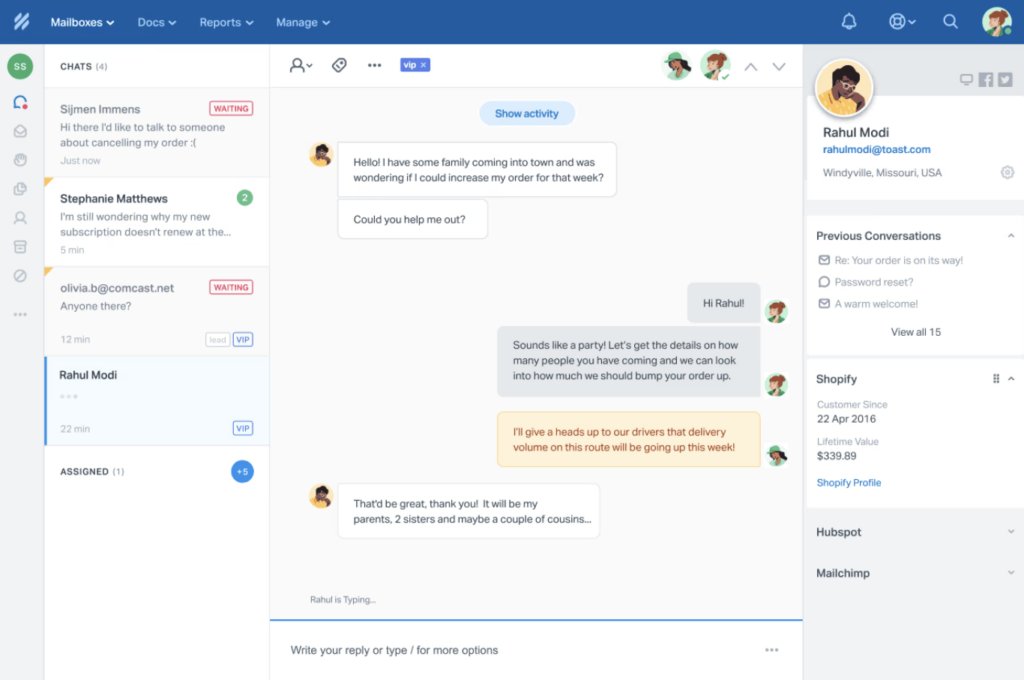
Recommended read: 10 best customer service software for small businesses
3. Team communication software
For small businesses, internal communication can often be managed via email or in-person meetings. But after you hit a certain headcount, let’s say 10 people, depending solely on email can get messy and chaotic.
Having back and forth discussions and keeping track of information shared via email becomes harder. At this point, investing in a dedicated team communication tool becomes essential to keep things organized, efficient, and ensure no message slip through the cracks.
Here are a couple of team communication tools I personally swear by.
Slack: Slack is a very well-designed team chat software. It’s extremely intuitive and easy to use, even for teams that aren’t tech savvy.
It allows you to split your conversations into different channels based on teams or projects which makes it easy to locate project or team-specific information from a particular channel.
Slack’s search feature is great too. Any specific message you want to look up, you can run a general search or a channel or chat-specific search to locate it. You can also filter by user, date, and more. It offers integrations with most major business software like Zoom, Google Drive and Asana.
The free version – that allows you to onboard unlimited users – is a popular choice but comes with some limitations on integrations and an upper cap on conversation history timeline. The paid version costs $8.75 per user per month.
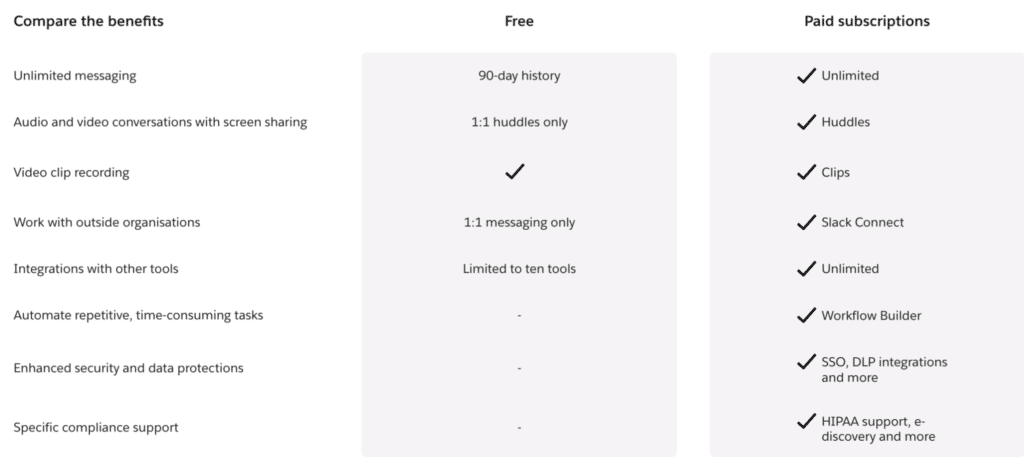
Discord: Although Discord is popular amongst gaming communities, it has slowly evolved into a versatile platform for team communication, especially for small businesses, startups, and creative teams. It allows you to create various channels for different teams, projects, or discussions. Text channels serve as a place for having back and forth conversations via text, while voice and video channels are great for meetings or brainstorming sessions.
One of the biggest advantages for small businesses is that Discord is free to use with unlimited message history. This is where it has a slight advantage over Slack.
While Discord doesn’t have as many native integrations as Slack, it still supports integrations with productivity tools like Trello, Google Calendar, and GitHub via third-party services like Zapier.
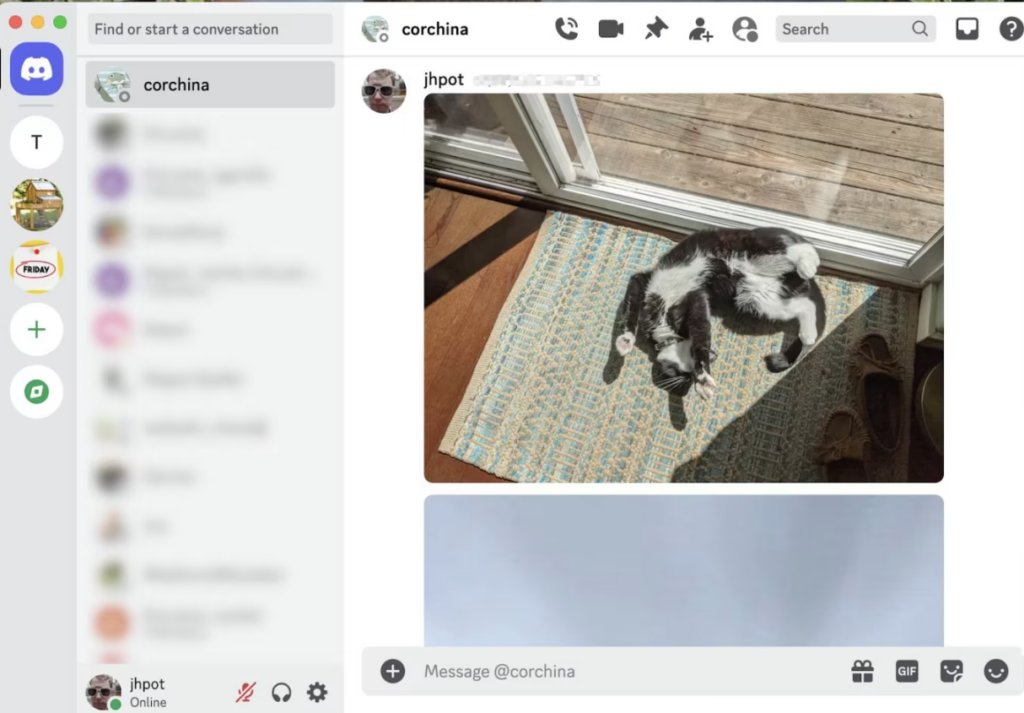
Here’s a Reddit thread with various users sharing their inputs on Slack vs Discord
4. Marketing automation tools
Another software solution your small business needs to invest in is a marketing automation tool. It’s a software that automates all your marketing communication via email, SMS, digital ads, and social media posts. These tools take care of the manual, repetitive tasks like sending emails, scheduling social media posts, and nurturing leads, allowing small teams to get more done with lesser time and effort spent.
Here are some examples of good marketing automation tools.
Brevo: Brevo, formerly known as Sendinblue, is a marketing automation software specifically built for small, growing businesses. It helps businesses manage their marketing efforts across multiple channels such as email, SMS, and even chat. Some of the key features of Brevo include:
- Email Marketing: Create and automate email campaigns easily. With a drag-and-drop editor, users can design responsive, professional-looking emails without needing any coding skills.
- Marketing Automation: Brevo’s automation workflows help businesses set up triggered emails, such as welcome emails or abandoned cart reminders. These workflows can be tailored based on customer behavior, ensuring the right message reaches the right audience at the right time.
- Analytics and Reporting: It also provides detailed reports on the performance of email campaigns, SMS messages, and automation workflows. This allows businesses to measure success, optimize their strategies, and improve overall campaign effectiveness.
Brevo’s paid plans start at $8 per month. It’s important to mention that the tool also has a forever-free plan.
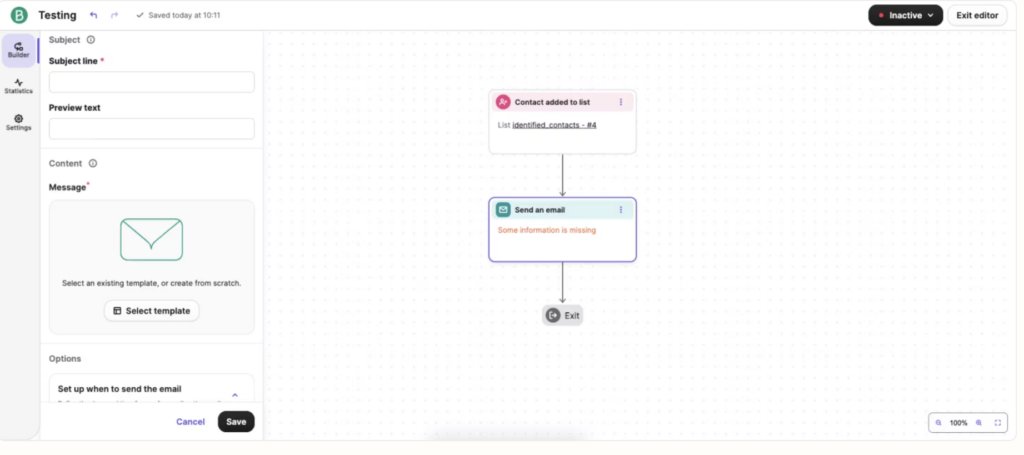
Omnisend: Omnisend is a comprehensive marketing automation tool for small businesses in the e-commerce vertical. Its free plan is very powerful and that’s what makes it such an attractive choice for teams on a tight budget.
Using Omnisend, you can automate emails, push notifications, and SMSs. The platform lets you choose from a large selection of pre-built workflows meant for different stages of the customer journey. There’s also an option to build your own workflows. You also get access to features like A/B testing of email campaigns and an AI assistant to write emails faster.
As I mentioned above, they have a powerful free plan. For more advanced features, the paid plan starts at $16 per month.
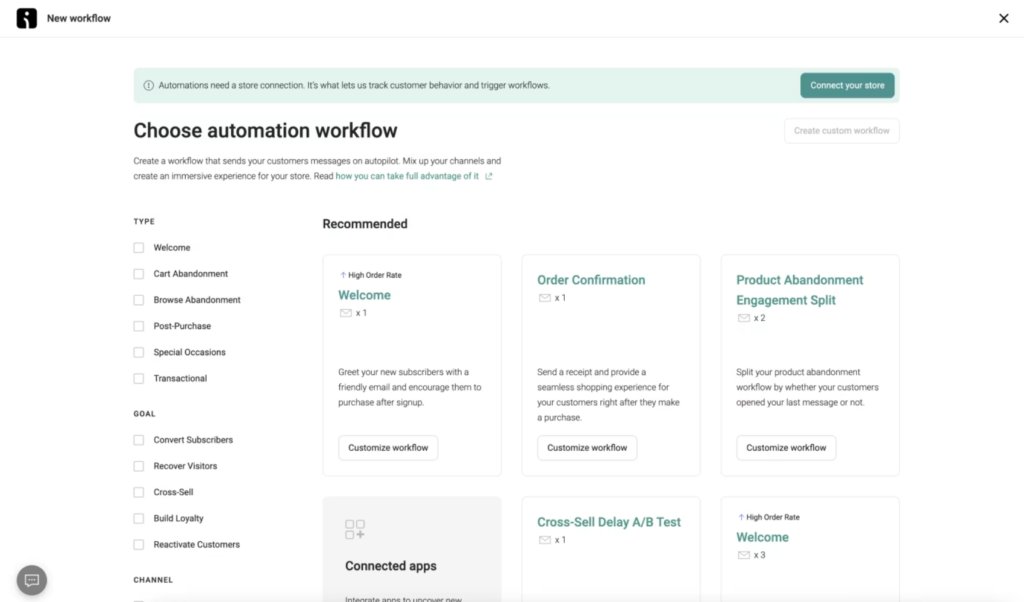
5. Task or project management software
Another important software to invest in for any small business is task or project management software. Task management tools help you assign, track, and prioritize tasks. Your team members know who is working on what and what the status of each task is. All in all it helps you ensure that projects are pushed over the line before the deadline without any delays.
Simply put, for smaller businesses, efficiency is a must. And these tools help your team become more efficient. Let’s look at some examples of good task management software.
Trello: Trello is an extremely user-friendly task management tool that makes use of a kanban board system to help teams manage projects visually. You can either create a board from scratch or choose one of the standard templates for marketing, sales, design etc. Each board can be set up to have different lists like backlog, in-progress, and completed.
The cards can include details like due dates, labels, attachments, images, comments, custom fields and much more. Once you’re done with a task, you can drag and drop it into a different list. There’s an activity menu to give you an overview of comments or tasks where you’re mentioned.
Trello has a free plan for up to 10 collaborators. You can upgrade to paid plans starting from $5 per user per month.

Asana: Asana is another effective project management tool. You get a default list view of the tasks which you can easily scan for due dates and assignees. You can switch between multiple layout formats – board, timeline, calendar, workflow or dashboard.
With Asana, you can either create task templates or use one of the pre-built ones and add any information you want like assignee, dates, descriptions and tags. The interface is quite clean and it’s very easy to navigate.
Asana is free for up to 10 members. Its paid plans start from $10.99 per user per month.

Kicking off your growth story as a small business
I think that does it for the bare essentials in terms of software solutions for small businesses looking to grow. It goes without saying that if budget permits, you can look to streamline other business functions such as hiring or go for tools that improve your team’sefficiency like AI chatbots.
Ultimately, your aim should be to empower your team to use tools that will make their lives easier and also help them do their jobs better. A well-equipped team and an obsession for customer satisfaction is all you’ll need to grow exponentially.

































